
Section 6

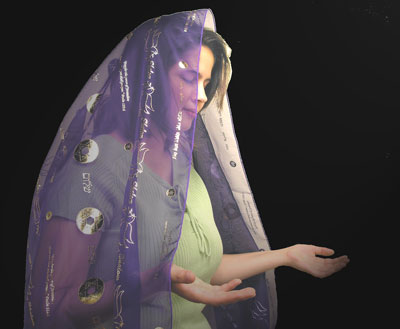
Revelation on the Master's Supper
and Women's Head Coverings
One of the very first revelations to the nascent New Covenant Assemblies concerned the true order of the Master's Supper and the symbolic appropriateness of women having long hair and covering their heads during worship services. Traditionally Christian Churches have a Communion Service in which a token amount of bread and wine is administered to communicants in a public meeting. In the revelation that follows, the Communion Service is portrayed as private and only for those who have judged themselves worthy by the full confession of their sins. The Master Himself promises to physically grace the Communion Service from time to time; in the same way that Jewish families leave a seat for Elijah the navi (prophet) in certain ceremonies, so Messianic Evangelicals leave a seat for the Master Yah'shua (Jesus) at the communion table. Another important principle stated from the very beginning of NCAY is the correct relationship between men and women, and between Christians and Christ. Wives are to be in subjection to their husbands as the Messianic Community (Church) is to be in subjection to her Master, as symbolically depicted by a woman covering her head at certain times and in certain places [Oxford, England, 16 November 1986].
1. On the evening of 16 November 1986 whilst reading the eleventh chapter of Paul's first letter to the Corinthians, I was overcome by the Ruach (Spirit) and began to understand the true meaning of what the apostle had written.
Women and Head Coverings
2. In reading the first sixteen verses I reflected on what I had been taught in the churches, viz. that the practice of women covering their heads during public worship was a local custom and not applicable to our day.
3. As I read the last verse of this section, which reads: "If anyone is disposed to be contentious, we recommend no other practice, nor to the assemblies (churches) of Elohim" (1 Cor.11:16, RSV), the Ruach bore affirmative witness to me that what Paul had said was true not only for this time, but for all times, and that man ought not to ignore the Davar Elohim (Word of God).
3. As I pondered on these matters further I realised that what Paul was in fact talking about was an eternal pattern concerning the relationship of Messiah to Elohim the Father, of man to Messiah, and of woman to man.
4. As I prayerfully meditated on what the sisters should do respecting head covering, the Ruach bore unmistakable testimony to me that they should obey the counsel of Paul as follows:
5. In public meetings the married women should cover their heads with a scarf or shawl in token of their submission and obedience to their husbands in the Master, as a witness both to Messiah and men that they are obedient servants of Elohim.
When Praying and Prophesying
6. This is not required of unmarried women save when they are praying and prophesying, to symbolise their submission and obedience to God.
Women and Long Hair
7. A woman should not cut her hair short in such a way as to resemble a man, for thus she dishonours her Head.
8. In the Temple of Yahweh, women shall be veiled at all times, save where otherwise directed, whether married or single.
9. And all this is to be done to honour Elohim and His precepts, recognising that in such symbols or ordinances lie the mystery of godliness and holiness.
10. Similarly men should not have long hair.
11. Having thus been enlightened by the Ruach of the Master I was about to close my Bible and retire to bed when the Ruach constrained me to read on.
The Agapé Meal
12. As I read verses 17-33 of 1 Corinthians 11 I was immediately made aware of the fact that most of the churches were not following the true pattern of the Agapé meal that Yah'shua had instituted at His last Passover in mortality which we have come to know as the Master's Supper, Lord's Supper, Holy Communion, Sacrament or Eucharist.
13. My mind was cast back to what I had been taught about the early Christian "love (apapé) feasts" -- that these had been meals and not simply the passing of tokens in a worship service.
Vision of Christ and the Eucharist
14. As I was thus meditating, a beautiful vision opened up to me.
15. I saw a long table around which were seated about a dozen qodeshim (saints) in reverent expectation.
16. The room was small and slightly darkened and appeared to be an antechamber of some chapel or meeting house. All was quiet.
17. On the table lay a loaf of bread, and before each person a simple wooden bowl.
18. By the loaf stood a jug filled with red unfermented wine.
19. I then saw myself standing at the end of the table about to read the sacramental prayers.
20. In an instant I was consumed with joy as the Ruach haQodesh rested upon me, for as I turned, there stood the Saviour in all His glory, shining brightly as the noon day sun.
21. He was adorned in resplendent long flowing white robes and was girt by a sache, the colour of which I could not see because the light was so intense, though I believe it may have been red.
22. His face was radiant with love and peace as He walked forward to the head of the table. I stepped aside.
23. He picked up the loaf and breaking it, said to us: "Take, eat; this in remem- brance of My body which I gave a ransom for you."
24. He then picked up the jug of wine and began pouring it into the bowls of the saints as they handed them to Him, and, having thanked His Father, said:
25. "Drink ye all of it. For this is in remembrance of the [blood of the] New Covenant, which is shed for as many as shall believe on My name, for the remission of their sins."
26. And when the qodeshim had eaten and drunk, He disappeared.
A Closed, Private Communion
27. I was overwhelmed by a feeling of love and peace as the vision closed, and the tears trickled down my cheeks.
28. I had seen a true communion service -- not a re-enactment of the Master's Supper in Jerusalem, but an ordinance for us in our day.
29. As I pondered what I had seen I realised that not only had there been no non-members there but that those members who had not made their peace with the Master were not there either.
30. It was not a public ordinance but a private one for the saints alone.
31. The Ruach then told me that prior to the qodeshim moving into the Communion Room, it was the duty of the Presiding Elder at the Sabbath Worship Service to challenge the qodeshim to examine themselves before entering the sacrament chamber, and that if any had ought {anything} against any member or the assembly as a whole, (s)he should either take the person aside whom (s)he had offended (or been offended by) and make confession, or make a public confession before the assembly in a matter affecting the assembly as a whole;
32. That the qodeshim should do this even before the Worship Services had begun in order not to detract from the solemnity of the occasion nor cause unnecessary delays.
33. Once those who had made their peace with their fellow man had entered the Communion Room, the Presiding Officer (usually the Pastor or Bishop) was to again challenge those seated at the Master's Table to examine themselves, and that if any had any ill feelings towards any man, (s)he was to withdraw immediately in order not to be an obstacle to the outpouring of the Ruach to the Body of communicants.
Regularity of Communion Services
34. Upon enquiring of the Master whether the communion should be held monthly or weekly, I was reminded that He had already spoken [to me] on the matter but that in addition it would be up to the Pastorate of a particular local assembly to choose how regularly they partook of the sacrament.
35. I understood that as the qodeshim grew more worthy and pure, they would desire to take the communion more regularly, and would be justified in doing so.
36. I also understood that special communion services should be held as the Pastor of a group is moved upon by the Ruach to do so.
37. Upon further enquiring whether communion should be served in the Temple, I was told that this would be revealed at a future date once direction for a European Temple had been received.
38. Words cannot describe the happiness and contentment I felt as I saw the vision.
Vision of the Earth
39. Shortly after this vision, and after I had enquired about the matters related above, a second vision was opened to me.
40. I saw the earth from space only it did not look like the earth as we know it, for the entire surface was covered with water so that no land masses could be seen.
41. It was a rich blue all over and as I found myself being drawn closer to the surface, I could hear and see the waves of the sea.
42. The vision then closed. I presumed that I was seeing the world as it was during the Great Flood but did not understand the connection between this and the vision I had seen of the Master's Supper, for experience has taught me that sequential visions are invariably about the same subject.
43. I understood this second vision to represent a 'baptism' (removal) of the old forms of Communion which have emerged in various Christian traditions, prior to the establishment of purer communion patterns that would open the way to greater outpourings of the Ruach in the future,
44. And with perhaps the promise that Yah'shua Himself would occasionally grace the Communion Table of those qodeshim who had purified their lives sufficiently and were partaking of the bread and wine in the manner ordained by the Elohimhead. Amen.

A. Headcoverings
vv.1-11 The importance and practical usefulness of this Section of the Olive Branch has been proven again and again over the years as this is a subject of contention that repeatedly arises, largely because of the rising momentum of feminism in the Western nations that seeks to violently overthrow patriarchy, gender rôles and family life. This has never been a problem in the Eastern Orthodox Church where the Pauline tradition has been maintained unbroken for over a millennium, and longer when you add the same-mindedness of the pre-Catholic/Orthodox Chalcedonian churches. The passage under consideration is as follows:
"Now I praise you, brethren, that you remember me in all things and keep the traditions just as I delivered them to you. But I want you to know that the head of every man is Messiah, the head of woman is man, and the head of Messiah is Elohim (God). Every man praying or prophesying, having his head covered, dishonours his head. But every woman who prays or prophesies with her head uncovered dishonours her head, for that is one and the same as if her head were shaved. For if a woman is not covered, let her also be shorn. But if it is shameful for a woman to be shorn or shaved, let her be covered. For a man indeed ought not to cover his head, since he is the image and glory of Elohim (God); but woman is the glory of man. For man is not from woman, but woman from man. Nor was man created for the woman, but woman for the man. For this reason the woman ought to have a symbol of authority on her head, because of the malakim (angels). Nevertheless, neither is man independent of woman, nor woman independent of man, in the Master. For as woman came from man, even so man also comes through woman; but all things are from Elohim (God). Judge among yourselves. Is it proper for a woman to pray to Elohim (God) with her head uncovered? Does not even nature itself teach you that if a man has long hair, it is a dishonour to him? But if a woman has long hair, it is a glory to her; for her hair is given to her for a covering. But if anyone seems to be contentious, we have no such custom, nor do the assemblies (churches, congregations) of Elohim (God)" (1 Cor.11:2-16, NKJV).
THE TRUE PATTERN VS. THE FALSE
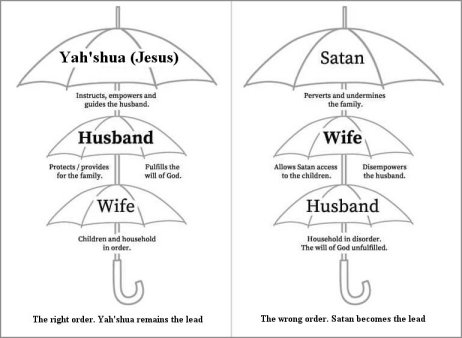 The Olive Branch commonly emphasises the divine order of gender rôles
The Olive Branch commonly emphasises the divine order of gender rôles
For feminists in particular, whose liberal proclivities and therefore influence on the churches has been gigantic but had not quite reached the fever pitch it has in the 2020's back in the 1980's when this Section was written, Paul is anathema, and this passage to the Corinthians is one of a set of scriptures particularly hated and villified by them. The way liberalised churches have got around Paul's teachings has been to make this a cultural issue with no application to the modern world (v.2). This particular revelation repudiates the liberal/feminist view (v.3). Rather, what is being described by Paul is an eternal tavnith or pattern, described by HIM as an apostolic "tradition", that is applicable in all ages to all congregations. The timeless validity of apostolic tradition holds for both the outward practices of the Kingdom as it does for matters moral and ethical bequeathed to the Messianic Community (Church) by the Tanakh (Old Testament) as is made plain by Paul's usage of the same term to the Thessalonians:
"But we command you, brethren, in the name of our Master Yah'shua the Messiah (Lord Jesus Christ), that you withdraw from every brother who walks disorderly and not according to the tradition which he received from us" (2 Thess.3:6, NKJV).
This is not Paul's personal opinion or 'tradition' but the Kingdom Rule of Faith held by all the apostles, with the mitzvah (commandment) to break fellowship with those who refuse to obey the apostolic injunction. Disfellowshipment is not a small thing, indicating that this ruling on head-covering and hair is one having the approbation of Heaven and is, in fact, New Covenant Torah, disobedience having consequences at the Judgment Seat of Christ at the Last Day. This was, is, and will always remain a uniform rule throughout all Messianic/Christian congregations, and is the unalterable rule of NCAY and of biblically-faithful assemblies and churches generally.
The shawl or headscarf, representing modesty, humility and submission (see top of page), was removed progressively in favour or showy, ornate displays of vanity, becoming in modern times especially an occasion to show-off fashion, weath and social status. This was true both in Western and African churches where secular hats and headwraps were worn to vie for attention by catching the carnal eye, just as immodest dress generally is donned for the same purpose (see Section 5 on Dress Standards). Most 21st century churches in the West do not even require the women to wear headcoverings, even in many 'conservative' churches.
Back in the 2010's a very desperate NCAY pastor in the East Africa Mission sought counsel of the Patriarchate because the women in one of his congregations were trying to outdo one another in their headdresses which were getting larger and more flamboyant. This Section and the website on headcoverings enabled him to navigate his way through the problem.
Hats worn in Western churches by women in the 1950's
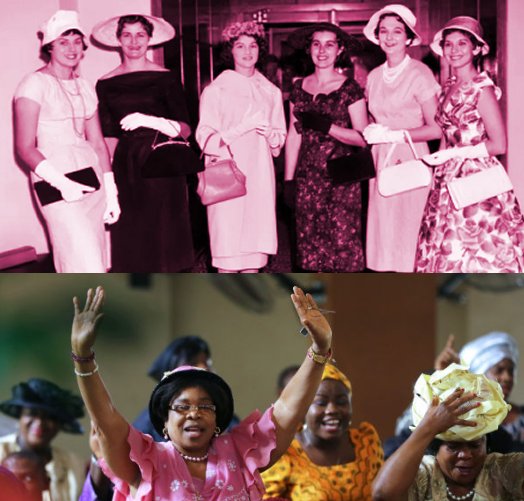 Headwraps worn in many African churches by women today
Headwraps worn in many African churches by women today
A parallel problem with the men exists in Messianic assemblies which have adopted rabbinical rules on the wearing of prayer shawls (tallit) and beanies (kippot) that run contrary to the apostolic rules and indeed the earlier pre-rabbinical Torah practices. NCAY forbids men from covering their heads when praying and prophesying in obedience to the rules established by Paul and the original Apostolate generally.
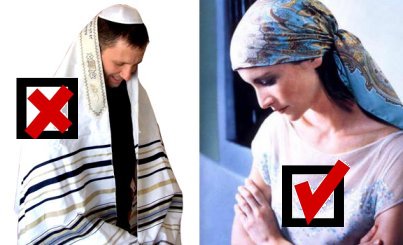
B. Hair Length and Hair-Covering
vv.7-11 The question of woman's hair length - short vs. long - has also been raised many times since the publication of this revelation in 1986. The main issue has always been maintaining clear gender distinctives, Torah mandating that women have 'long' and men have 'short' hair. Where the line should be drawn has never been officially commented on by NCAY save in the most general of terms, perhaps, as with the issue of beards, because some women are genetically disposed not to be able to grow long hair, making a hard-and-fast rule unworkable. Gender distinctives and modesty are the key words here.
On only one occasion did we have to deal with a sister who refused to wear a headcovering because she claimed that her hair was her covering, based on a twisting of 1 Corinthians 11:5 which in the English translates two different words as 'covering' - peribolaion (hair as a covering) and katakalupto (the shawl as a covering) - see Should a Christian Woman Wear a Headcovering?. A variant of this scriptural abuse is the claim by some Messianic/Christian women that a wig acts as a bona fide headcovering, the inspiration for which has been copied from the practice of some Orthodox Jewish women who do the same. However, Jewish women (and the men, for that matter, who wear prayer shawls or tallit) lack the instruction of the Messianic Scriptures (New Testament). A wig is artificial hair, and therefore an artificial peribolaion and not a true katakalupto. This does not mean that a woman cannot wear a wig but it does mean that it does not constitute a true covering when praying and prophesying. If she wishes to wear the unlikely combination of an artificial peribolaion (wig) and a katakalupto (head shawl) together she is at liberty to do so.
C. The Master's Supper, Communion, Eucharist
vv.12-37 These verses of Section 6, coupled with the ancient Syrian Didaché and progressive revelations on the festivals of Israel, form the template of what has since grown to become the Liturgy of the Master's Supper as currently observed by Messianic Evangelicals. The sermon, Pesach (Passover) and the Eucharist of Messiah, lays out the various components. In more recent times, further revelation on the relationship between the Passover Meal, the Master's (Lord's) Supper and the Agapé Meal have filled this picture out even more fully - see the Ancient Connections series, and in particular Ordinary Meals That Became Sacred and Pesach, the Master's Supper & Sukkot.
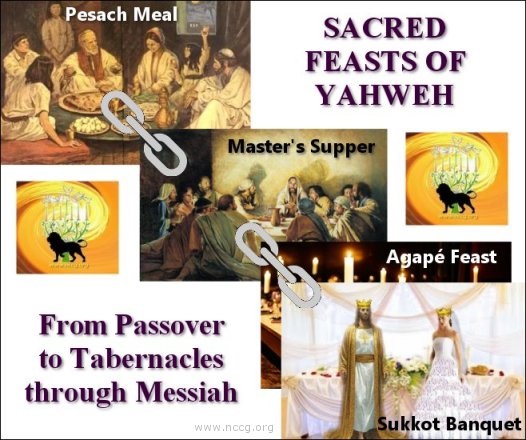
The part of Section 6 that deals with the Master's Supper and Agapé Feast is based on a vision I saw while meditating on Scripture in which Christ appeared administering the emblems in a way I had not before encountered in any of the denominations I had either been a part of growing up in (Anglican) or seen elsewhere in other denominations.
As stated in the revelation, the ordinance depicited in the vision was not a duplication of what transpired at the 'Last Supper' in Jerusalem 2,000 years ago but a fusion of sorts between the Master's Supper (which in its original form was added to the end of the Passover Meal) and the Agapé Meal described by Paul. This was over a decade before NCAY became formally messianic/Torah-obedient at which time little was known about Yahweh's divine moedim (appointments). Given the Sukkot (Tabernacles) banquet has not yet taken place (since Messiah has not yet returned), and given that the Agapé (Love) Feast was, and is, a foreshadowing of the Marriage Supper of the Lamb in Revelation 19:9 (see diagram above), the temporary fusion of the two in the interim period, as revealed in the vision, makes a great deal of sense, especially as the Agapé Meal came to be abused in the first century AD.
One of the unique features of the Messianic Evangelical Liturgy is the requirement, mandated by the revelation, for the qodeshim (saints, set-apart ones) to have a formal period of time immediately before partaking the elements for self-examination and, where, necessary the restoration of broken relationships through confession. This particular feature, when introduced for the first time into the earliest NCAY assemblies in Norway, and particularly in Oslo where it was pioneered, had a very powerful effect upon the communicants (vv.31-33), and resulted in a most open, sublime and peaceful atmosphere in which the Ruach (Spirit) freely flowed, that passed into the subsequent Sabbath meetings for the benefit of all, including those who had not been present beforehand.
The frequency with which the Master's Supper is to be taken is left open in the revelation (vv.34-36). There is great variation between the denominations, from those like most Messianics and the Jehovah's Witnesses who observe this ordinance but once a year at Pesach (Passover) in the spring to most of the orthodox denominations who usually observe it once a week (on Sundays) or once a month. Some Messianics, taking the lead from Protestants and others for the most part, take the elements on their Friday-sunset to Saturday-sunset rabbinical sabbaths. Since 2011, when NCAY aligned itself with the Creation Calendar, Messianic Evangelicals have usually partaken of the Master's Supper at some time convenient to the local congregation each Sabbath day, preferably before the main services.
D. Vision of the Earth
Section 6 closes with a second and (at the time) quite unexpected vision of the world following the Great Flood symbolising the washing away of all the old denominational forms of the Master's Supper preparatory to a new and exciting experience (vv.39-44).
E. Miscelleneous
The Master's Supper is both a personal (Pesach) and a communal or coportate covenant (Shavu'ot and Sukkot), the latter being the chief (though not the only) reason it is a closed communion (v.29).
F. A Vacant Seat for the Saviour
The tradition of leaving a place vaccant at the communion table for the Saviour, not mentioned in this or any other revelation in the Olive Branch let alone the Bible, was seldom practiced in the early NCAY branches and quickly fell out of use after the relocation to Sweden in 1997. This idea was likely inspired by the Jewish rabbinical tradition of setting a place for Elijah each year at the annual Passover celebration table, together with a cup filled with wine, and leaving the front door open for him to come in, which I had heard about somewhere. Though the possibility is mentioned of Yah'shua (Jesus) physically turning up to a communion service one day in the future, the revelation is vague and should not be interpreted to mean that this will definitely happen (v.44).
G. NCAY Temples
The construction of physical temples (v.37) yet remains to be undertaken . Though numerous plans were drawn up in the early days of NCAY, the rejection of the initial work in 1992, and the subsequent exodus from Norway to Sweden, has precluded this happening and the responsibility for the task may well fall on the last generation in the 12 cities of refuge, even though rooms have always been available for the purpose in Kadesh-biyqah, NCAY's headquarters and home of Mishpachah Lev-Tsiyon (MLT), the central or mother congregation of NCAY. Numerous revelations on this structure, which has nothing to do with the Mosaic Temples of the Old Covenant or the temples of other religions, may be found in the Olive Branch and are therein referenced (p.1053). NCAY temples exist solely for the purpose of preaching, instruction, prayer, worship and important events like conferences, festivals, marriages and covenant-taking generally (like the Master's (Lord's) Supper, baptism and Bar/Bat-Mitzvah). The one in Sweden is also used by MLT for weekly Sabbath and monthly Rosh Chodesh assemblies. There will never be more than 12 temples, one each for the assembled Tribes of Israel in the Final Gathering.
(7 November 2020)

If you would like to purchase a copy of the whole book of revelations, which includes
an extensive commentary, concordance, index and relevant articles, click the book below:

This page was first created on 3 August 1997
Last updated on 7 November 2020
Copyright © 1997-2020 NCAY - All Rights Reserved


